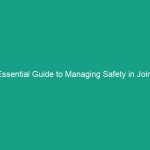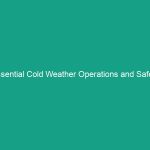Good Morning Team!
Today, we’re going to talk about an important topic that can significantly affect our daily operations and overall well-being: Must-Know Guidelines to Prevent Slips and Ensure Workplace Safety. Slips, trips, and falls are among the leading causes of workplace injuries, and understanding how to prevent these incidents is crucial for a safe work Environment.
Understanding Must-Know Guidelines to Prevent Slips and Ensure Workplace Safety
The term Must-Know Guidelines to Prevent Slips and Ensure Workplace Safety encompasses a set of practices and principles designed to mitigate the risk of falls in the workplace. These guidelines are essential not only for compliance with Safety Regulations but also for protecting our colleagues from unnecessary injuries.
Ignoring these guidelines can lead to serious injuries, lost workdays, and even legal consequences. It’s vital for everyone to understand their role in maintaining a safe workplace.
Key Hazards, Risks, and Safety Considerations
Slips and falls can occur in various scenarios within the workplace. Here are some common Hazards to keep in mind:
- Wet or Slippery Floors: Spills, leaks, or cleaning processes can create slick surfaces.
- Uneven Surfaces: Cracks, potholes, or uneven flooring can increase the risk of tripping.
- Cluttered Walkways: Items left in passageways can pose significant trip hazards.
- Improper Footwear: Shoes without adequate traction can contribute to slips.
Ignoring these hazards can lead to serious consequences such as fractures, concussions, or even fatalities. It’s essential to remain vigilant and proactive in identifying and addressing these risks.
Best Practices, Procedures, & Actionable Advice
To prevent slips and ensure Workplace Safety, here are some Best Practices to implement:
1. Maintain Clean and Dry Floors
Always clean up spills immediately and use warning signs to alert others of wet floors. Designate specific personnel to regularly inspect and clean common areas.
2. Use Proper Footwear
Encourage employees to wear shoes with non-slip soles. Providing guidelines on appropriate footwear can significantly reduce slip risks.
3. Keep Walkways Clear
Ensure that all walkways are free of clutter and obstacles. Regularly inspect and organize storage areas to avoid tripping hazards.
4. Install Proper Lighting
Ensure that all areas are well-lit, especially stairways and entrances. If necessary, add additional lighting fixtures to improve visibility.
5. Conduct Regular Safety Training
Regular training sessions can keep safety at the forefront of employees’ minds. Use these sessions to review slip Prevention strategies and discuss recent incidents.
6. Use Safety Mats
In areas prone to spills, consider using anti-slip mats or rugs to provide additional traction.
Real-World Examples
Consider the case of a warehouse worker who slipped on a wet floor, resulting in a serious injury. The investigation revealed that the spill had gone unaddressed for hours due to a lack of proper cleaning protocols. This incident not only affected the injured employee but also disrupted operations and led to increased insurance costs.
Regulations, Standards, and Compliance
Adhering to safety Standards is critical for maintaining a safe workplace. The Occupational Safety and Health Administration (OSHA) has established guidelines for slip prevention, including:
- Ensuring floors are properly maintained and free of hazards.
- Providing adequate training for employees on slip prevention.
- Documenting all safety inspections and incidents.
Compliance with these regulations not only protects employees but also helps the company avoid potential legal issues and fines.
Employee Engagement & Discussion
Now that we’ve covered the guidelines, I want to hear from you! What safety challenges have you encountered related to slips and falls? Are there any specific areas in our workplace that you think require more attention?
Encouraging open dialogue about safety can help us identify potential hazards and improve our practices.
Conclusion & Key Takeaways
In conclusion, the Must-Know Guidelines to Prevent Slips and Ensure Workplace Safety are essential for protecting ourselves and our colleagues. Remember to:
- Maintain clean and dry floors.
- Wear proper footwear.
- Keep walkways clear.
- Ensure adequate lighting.
- Engage in regular safety training and discussions.
Let’s prioritize safety in our workplace every day. Thank you for your attention and your commitment to maintaining a safe environment for everyone!


